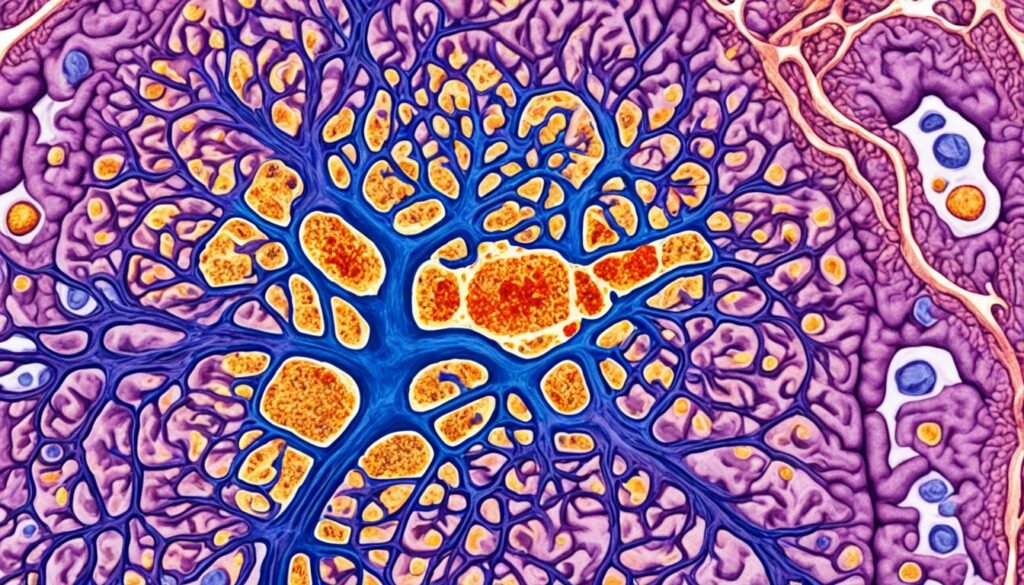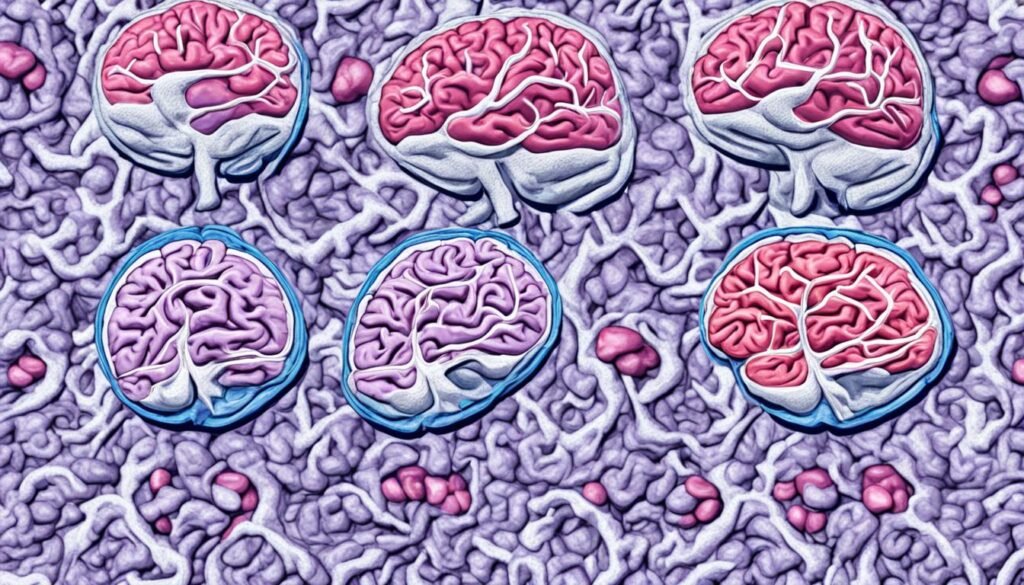A brain tumor is an abnormal mass of tissue in the brain or near it, with over 150 different types documented. Understanding the different types of brain tumors is essential for accurate diagnosis and appropriate treatment options.
Types of brain tumors can be broadly classified into primary and metastatic tumors. Primary brain tumors originate from the brain tissues or its surroundings, while metastatic tumors spread to the brain from other parts of the body.
Primary brain tumors can be further categorized as glial or non-glial, benign or malignant. Glial tumors originate from the glial cells of the brain and are further classified into astrocytomas, oligodendrogliomas, and ependymomas. Non-glial tumors, also known as meningiomas, originate from the membranes covering the brain and spinal cord.
Metastatic brain tumors, on the other hand, are cancers that have spread to the brain from other parts of the body, such as the lungs, breast, or skin. They are considered malignant and can affect nearly one in four cancer patients.
Key Takeaways:
- There are over 150 different types of brain tumors.
- Brain tumors can be classified as primary or metastatic.
- Primary brain tumors can be glial or non-glial, and benign or malignant.
- Metastatic brain tumors spread to the brain from other parts of the body and are considered malignant.
- Accurate diagnosis is crucial for determining appropriate treatment options.
Table of Contents
ToggleTypes of Benign Brain Tumors
Benign brain tumors, also known as non-cancerous brain tumors, are slow-growing tumors that do not spread to other parts of the body. Unlike malignant tumors, benign brain tumors do not invade nearby tissues and are usually less aggressive in nature. These tumors are typically non-cancerous, meaning they do not pose the same risks and complications associated with cancer. Understanding the different types of benign brain tumors can provide valuable insights into their characteristics, prevalence, and prognosis.
There are several types of benign brain tumors that can occur in different areas of the brain. Each type has its own unique characteristics and growth patterns, which can help determine the most suitable treatment approach. Here are some common types of benign brain tumors:
- Chordomas
- Craniopharyngiomas
- Gangliocytomas
- Glomus jugulare tumors
- Meningiomas
- Pineocytomas
- Pituitary adenomas
- Schwannomas
These types of benign brain tumors can vary in location, prevalence, and growth characteristics. For example, meningiomas originate from the meninges, the protective layers surrounding the brain and spinal cord, and are the most common type of benign brain tumor. Pituitary adenomas form in the pituitary gland, a pea-sized gland located at the base of the brain, and can affect hormone production. Schwannomas develop from the Schwann cells, which are responsible for supporting and insulating nerve cells in the peripheral nervous system.
While benign brain tumors are generally less aggressive than malignant brain tumors, they can still cause symptoms and complications depending on their size and location. Treatment options for benign brain tumors may include observation, surgery to remove the tumor, radiation therapy, or a combination of these approaches. The prognosis for benign brain tumors is generally better compared to malignant tumors, with a higher likelihood of complete recovery and long-term survival.

Types of Benign Brain Tumors
| Type of Benign Brain Tumor | Prevalence | Growth Characteristics | |
|---|---|---|---|
| Chordomas | Rare | Slow-growing | |
| Craniopharyngiomas | Common in children, rare in adults | Slow-growing, tend to recur | |
| Gangliocytomas | Rare | Slow-growing | |
| Glomus jugulare tumors | Rare | Slow-growing | |
| Meningiomas | Common | Slow-growing | |
| Pineocytomas | Rare | Slow-growing | |
| Pituitary adenomas | Common | Slow-growing, hormone-producing | |
| Schwannomas | Slow-growing |
Types of Malignant Brain Tumors
Malignant brain tumors are cancerous tumors that pose a serious threat to the surrounding brain tissue. Unlike benign brain tumors, malignant tumors can invade and destroy healthy cells, leading to severe health complications.
The most common type of malignant brain tumor is glioma, accounting for approximately 78% of all malignant brain tumors. Gliomas originate from the supportive tissue of the brain and can rapidly grow and spread to different areas. The most aggressive form of glioma is glioblastoma, which is known for its rapid invasion and resistance to treatment.
Other types of malignant brain tumors include:
- Ependymomas: Originating from the ependymal cells that line the ventricles of the brain, ependymomas are often found in children and adults. They can manifest in different locations within the brain and spinal cord.
- Medulloblastomas: Primarily affecting children, medulloblastomas develop in the cerebellum, the part of the brain responsible for coordination and balance. These tumors are highly malignant and require prompt medical intervention.
- Oligodendrogliomas: Arising from the oligodendrocytes, cells responsible for producing the protective myelin sheath around nerve cells, oligodendrogliomas are typically found in the frontal and temporal lobes of the brain. They tend to grow slowly but can still lead to significant neurological impairments.
To provide a comprehensive understanding of the types of malignant brain tumors, here is a table summarizing the key characteristics:
| Brain Tumor Type | Growth Rate | Prognosis | |
|---|---|---|---|
| Glioma | Rapid | Generally poor | |
| Ependymomas | Varies | Depends on location and stage | |
| Medulloblastomas | Rapid | Generally poor | |
| Oligodendrogliomas | Slow | Varies based on grade |

Understanding the different types of malignant brain tumors is crucial in determining the appropriate treatment plan and prognosis for affected individuals. While advances in medical research and technology continue to improve treatment outcomes, early detection, diagnosis, and timely intervention remain crucial for a better chance at recovery.
Other Types of Brain Tumors
While primary and metastatic brain tumors are the most common types, there are also other rare and unique brain tumors that can occur. These tumors require specific attention and understanding due to their distinct characteristics and treatment approaches.
Rare Brain Tumors
In addition to primary and metastatic tumors, there are several rare brain tumors that have unique features. One such tumor is the hemangioblastoma, which develops in blood vessels and is more commonly found in adults. Hemangioblastomas are typically slow-growing and may not cause noticeable symptoms for a long time.
Another rare and highly aggressive brain tumor is the rhabdoid tumor. These tumors tend to spread quickly throughout the central nervous system, making early detection and treatment vital. Rhabdoid tumors can affect both children and adults.
Pediatric Brain Tumors
Brain tumors in children often differ from those in adults and require specialized care. Several types of pediatric brain tumors can affect children and adolescents:
- Medulloblastomas, which primarily occur in the cerebellum and are the most common malignant brain tumors in children.
- Low-grade astrocytomas, which are slow-growing tumors that develop from brain cells called astrocytes.
- Ependymomas, which primarily affect the lining of the ventricles and spinal cord.
- Craniopharyngiomas, which originate near the pituitary gland and can affect hormone production.
- Brainstem gliomas, which develop in the brainstem and can pose unique challenges due to their location.
Table: Pediatric Brain Tumor Types
| Brain Tumor Type | Characteristics | |
|---|---|---|
| Medulloblastomas | Most common malignant brain tumor in children. | |
| Low-grade astrocytomas | ||
| Ependymomas | ||
| Craniopharyngiomas | Can impact hormone production and growth. | |
| Brainstem gliomas | Challenging due to the location and potential impact on vital functions. |

It is crucial to recognize the unique characteristics of rare and pediatric brain tumors to ensure appropriate diagnosis and treatment. Advances in medical research continue to shed light on these tumor types, leading to improved outcomes and enhanced quality of life for patients facing such challenges.
World Health Organization (WHO) Brain Tumor Grades
When it comes to brain tumors, the World Health Organization (WHO) has developed a grading system that helps determine their malignancy. This grading system plays a crucial role in understanding the aggressiveness of the tumor and predicting its prognosis.
There are four grades in the WHO brain tumor grading system, each indicating different levels of malignancy:
- Grade I: The least malignant tumors fall under this category. They are usually slow-growing and have well-defined borders. Grade I tumors are often considered potentially curable with surgery alone. However, close monitoring is necessary as they can sometimes recur or progress to higher grades.
- Grade II: These tumors are relatively slow-growing like Grade I tumors. However, they infiltrate nearby tissues and have less well-defined borders. Grade II tumors have the potential to recur as higher-grade tumors over time.
- Grade III: Malignant and infiltrative, Grade III tumors are more aggressive than Grade I and Grade II tumors. They tend to have a higher likelihood of recurrence, often progressing to higher grades. Grade III tumors require a comprehensive treatment approach.
- Grade IV: The most malignant and aggressive tumors, Grade IV tumors exhibit rapid growth and invasion into surrounding brain tissue. They are prone to necrosis and often recur quickly. Grade IV tumors necessitate immediate and aggressive treatment.
Understanding the WHO brain tumor grades can help healthcare professionals determine the appropriate treatment plan and provide patients with a more accurate prognosis. The grading system plays a vital role in guiding clinical decision-making and ensuring the best possible outcome for individuals diagnosed with a brain tumor.
Incidence and Causes of Brain Tumors
The incidence of brain tumors is a significant concern, with thousands of adults being diagnosed each year. According to the National Cancer Institute, the brain tumor incidence is estimated to be over 22,000 cases annually. Understanding the causes of brain tumors is crucial in order to develop effective prevention and treatment strategies.
The exact causes of brain tumors are still unknown, but scientific research has provided valuable insights into the underlying factors. Genetic factors play an important role in the development of brain tumors. Certain genes on the chromosomes of brain cells can become damaged or mutated, leading to uncontrolled cell growth and the formation of tumors. Genetic disorders, such as neurofibromatosis type 1, have been associated with an increased risk of developing brain tumors.
In addition to genetic factors, environmental influences can also contribute to the development of brain tumors. Exposure to ionizing radiation, both from medical procedures and environmental sources, has been linked to an increased risk of brain tumors. Other potential environmental factors include exposure to certain chemicals and toxins, as well as lifestyle factors such as smoking and diet.
While the exact mechanisms behind brain tumor development are complex and multifactorial, ongoing research aims to deepen our understanding of the causes and risk factors. By identifying these factors, healthcare professionals can better educate the public and implement strategies to reduce the incidence of brain tumors.

Symptoms of Brain Tumors
The symptoms of a brain tumor can vary depending on its size, location, and rate of growth. It’s important to be aware of these symptoms as early detection can lead to prompt diagnosis and treatment.
Common Symptoms
Here are some common signs and symptoms associated with brain tumors:
- Headaches: Headaches are a common symptom of brain tumors, particularly ones that are located near the brain’s surface. These headaches are often worse in the morning and can be accompanied by other symptoms such as neck pain or eye pain.
- Nausea: Persistent nausea or vomiting, unrelated to any other known condition, can be an indication of a brain tumor.
- Vision problems: Changes in vision, including blurred or double vision, loss of peripheral vision, or seeing flashing lights or spots, may be a sign of a brain tumor affecting the optic nerves or visual pathways.
- Loss of feeling or movement in limbs: A brain tumor can cause weakness or numbness in certain parts of the body, which may start in one limb and gradually spread to others.
- Balance difficulties: Tumors located in the cerebellum, the region responsible for balance and coordination, can lead to problems with balance and coordination.
- Speech problems: Brain tumors can affect speech and language abilities. You may experience difficulty finding words or speaking clearly.
- Fatigue: Unexplained fatigue or drowsiness, even after getting enough rest, can be a symptom of a brain tumor.
- Memory problems: Memory loss, difficulty concentrating, and changes in cognitive function can be signs of a brain tumor.
- Personality changes: Brain tumors can cause changes in mood, behavior, or personality. You may experience irritability, depression, or sudden emotional swings.
- Seizures: Seizures, which may involve involuntary movements or loss of consciousness, can be a symptom of a brain tumor.
- Hearing problems: Brain tumors near the auditory nerves can lead to hearing loss or ringing in the ears.

It’s important to note that the presence of these symptoms does not necessarily mean you have a brain tumor. Many of these symptoms can also be caused by other conditions. However, if you experience any of these symptoms persistently, it’s important to consult a healthcare professional for a proper evaluation and diagnosis.
Brain Tumor Treatment Options
The treatment of brain tumors depends on various factors such as the type of tumor, its size, and location within the brain. The primary treatment options for brain tumors include:
- Brain Tumor Surgery: In many cases, surgery is the first line of treatment for brain tumors. The goal of surgery is to remove as much of the tumor as possible, while preserving the surrounding healthy brain tissue. The extent of the surgical resection depends on factors such as the tumor’s location and its relationship to vital brain structures. Surgical removal of the tumor can help alleviate symptoms, reduce the tumor size, and improve the overall prognosis.
- Radiation Therapy: Radiation therapy uses high-energy X-rays or other forms of radiation to kill cancer cells and shrink tumors. It is often recommended for brain tumors that cannot be completely removed through surgery or for tumors that are sensitive to radiation. Radiation therapy can be delivered externally using a machine called a linear accelerator, or internally through the placement of radioactive material directly into the tumor (brachytherapy).
- Chemotherapy: Chemotherapy involves the use of drugs to kill cancer cells or inhibit their growth. It can be administered orally or intravenously and is often used in combination with surgery and radiation therapy. Chemotherapy is particularly useful for brain tumors that are difficult to reach surgically or that have spread to other parts of the central nervous system. The specific chemotherapy drugs and treatment regimen are determined based on the tumor type and individual patient factors.
It is important to note that the treatment approach for brain tumors is highly individualized, and a combination of these treatment options may be recommended based on each patient’s unique circumstances. The goal of treatment is to effectively manage the tumor, control its growth, alleviate symptoms, and improve the patient’s quality of life.

Conclusion
Understanding brain tumors and the various types and treatment options available is crucial in the diagnosis, management, and treatment of these complex diseases. Brain tumors encompass a diverse range of conditions, each requiring individualized care and attention.
Advancements in medical technology and ongoing research efforts are continuously improving the prognosis and quality of life for individuals diagnosed with brain tumors. Timely diagnosis, early detection, and increased awareness can play a significant role in improving outcomes and supporting ongoing research initiatives.
It is essential for individuals and their families to be well-informed about the different types of brain tumors, their characteristics, and the available treatment options. By understanding the nature and complexities of these diseases, individuals can make informed decisions and actively participate in their own healthcare journey.
Brain tumor awareness is of utmost importance to ensure early detection, timely intervention, and comprehensive support for affected individuals and their caregivers. By raising awareness about brain tumors and dispelling misconceptions, we can promote a greater understanding and empathy towards those impacted by these conditions.
FAQ
What are the different types of brain tumors?
There are over 150 different types of brain tumors, including primary and metastatic tumors. Primary tumors originate from the brain tissues or its surroundings, while metastatic tumors spread to the brain from other parts of the body.
What are the types of benign brain tumors?
The types of benign brain tumors include chordomas, craniopharyngiomas, gangliocytomas, glomus jugulare tumors, meningiomas, pineocytomas, pituitary adenomas, and schwannomas. These tumors are generally non-cancerous, slow-growing, and have a better prognosis than malignant brain tumors.
What are the types of malignant brain tumors?
The most prevalent type of malignant brain tumor is glioma, accounting for 78% of all malignant brain tumors. Other types include ependymomas, medulloblastomas, and oligodendrogliomas. Malignant brain tumors are cancerous, invasive, and have a poorer prognosis compared to benign brain tumors.
Are there other types of brain tumors?
Yes, other types of brain tumors include hemangioblastomas, rhabdoid tumors, and pediatric brain tumors. Hemangioblastomas are slow-growing tumors that form in blood vessels, rhabdoid tumors are highly aggressive, and pediatric brain tumors specifically affect children and include medulloblastomas, low-grade astrocytomas, ependymomas, craniopharyngiomas, and brainstem gliomas.
What is the World Health Organization (WHO) grading system for brain tumors?
The WHO has developed a grading system to indicate the malignancy of brain tumors. Grade I tumors are the least malignant, while grade IV tumors are the most malignant and aggressive.
How many adults are diagnosed with brain tumors each year?
The National Cancer Institute estimates that over 22,000 adults are diagnosed with brain tumors in a year.
What causes brain tumors?
The exact causes of brain tumors are still unknown, but scientists believe that certain genes on the chromosomes of brain cells may become damaged and lead to the development of tumors. Environmental factors and genetic disorders can also contribute to the development of brain tumors.
What are the symptoms of brain tumors?
The symptoms of a brain tumor vary depending on the tumor’s size, location, and rate of growth. Common symptoms include headaches, nausea, vision problems, loss of feeling or movement in limbs, balance difficulties, speech problems, fatigue, memory problems, personality changes, seizures, and hearing problems.
What are the treatment options for brain tumors?
The treatment options for brain tumors depend on the type, size, and location of the tumor. Common treatment options include surgery to remove the tumor, radiation therapy to target and kill cancer cells, and chemotherapy to destroy cancer cells using drugs.
Source Links
- https://www.aans.org/en/Patients/Neurosurgical-Conditions-and-Treatments/Brain-Tumors
- https://www.hopkinsmedicine.org/health/conditions-and-diseases/brain-tumor/brain-tumor-types
- https://www.mayoclinic.org/diseases-conditions/brain-tumor/symptoms-causes/syc-20350084
Also Read
Understanding Different Types of Brain Tumors: A Comprehensive Guide
5 Effective Methods for Brain Tumor Treatment without Surgery
Can Stress Cause Brain Tumors? Unpacking the Myth
About The Author

This article is medically reviewed by Dr. Chandril Chugh, Board-Certified Neurologist, providing expert insights and reliable health information.
Dr. Chandril Chugh is a U.S.-trained neurologist with over a decade of experience. Known for his compassionate care, he specializes in treating neurological conditions such as migraines, epilepsy, and Parkinson’s disease. Dr. Chugh is highly regarded for his patient-centered approach and dedication to providing personalized care.
→ Book a consultation to discover which remedies suit your needs best.




